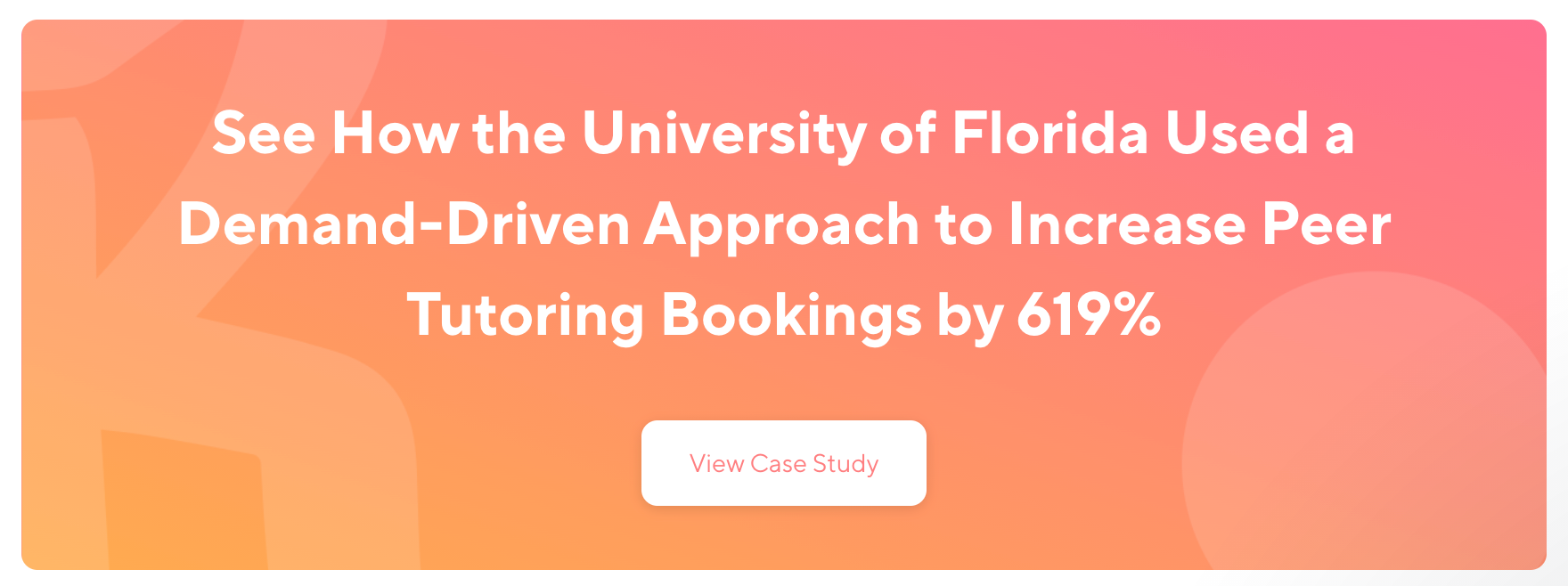7 min read
Demand-Driven Support as an Alternative to Traditional Staffing Practices
By: Marissa Bastian on Jan 10, 2021 8:01:00 AM

Trying to prepare your tutoring or learning center for the upcoming academic year can feel a lot like trying to use a cloudy crystal ball.
You need to determine how many tutors you can hire, what courses you should cover, and how many hours of coverage you can provide based on your budget. Many tutoring program directors and coordinators across the country experience a similar feeling of anxiety mixed with hope (and a little fortune telling) as they get ready for the new year.
With the unique challenges of each incoming class and every academic year, tutoring programs do their best to provide services to best support students’ needs. The difficulty is that we don’t necessarily know exactly what students need until the semester has begun and they’ve started their classes. At that point, it can be difficult to know if you’ve hired the right tutors to cover the necessary courses based on student demand.
What happens if you have significant demand for courses that your tutors can’t cover? By that time, you may not have room in your budget to pivot to hire additional tutors to cover the relevant course(s), but you still want to support those students seeking help and, as such, don’t want to turn them away.
The desire to avoid these situations can fill you with anxiety because you’re trying to staff the unknown. You’re using historical data and educated guesses to best prepare your center and staff. You’re providing the supply (tutors and hours) without truly knowing what the demand (student needs) will be.
What is Demand-Driven Tutoring?
Enter the independent contractor model for providing peer tutoring — also known as demand-driven support. This model allows you to scale your existing staffed peer tutors (“W2 Tutors”) and stand up a flexible network of supplemental peer tutors from your campus (“1099 Tutors”) for online and on-campus support.
Using technology to power the 1099 model, you can easily pivot throughout the academic year to ensure that you have enough tutors available to support student demand. Since these tutors are paid only for the time that they spend tutoring students, you won’t lose any of your limited budget to no-shows, cancelations, or empty rooms (virtual or in-person).
Furthermore, you still get to decide who can be a tutor for your campus. Most schools allow any students who have earned an A- or better in a course to be a tutor, but you can also require tutors to complete training, submit a faculty recommendation, or meet any other desired standards.
Lastly, you still maintain complete control over your budget, since you decide how much tutors are paid (most Knack campuses pay $10 to $15 per hour). Utilizing the right technology to power this network will ensure that tutors are only paid for the amount of time that they actually spend with their students, ensuring that you get exactly what you pay for.
Benefits of the Demand-Driven Model
We recognize that this is a different model compared to how tutoring centers typically offer peer tutoring. That said, we’ve also seen firsthand that responding to student demand — rather than trying to predict it — can provide significant benefits to all stakeholders.
Tutor Benefits
With the 1099 model, tutors are allowed more flexibility with their availability. Being able to choose their own work schedule, even outside of traditional center hours, allows for increased autonomy with regard to when they meet with students. With so many tutors participating in other campus activities, letting them choose their own hours helps you hire more tutors who are engaged and dedicated. You won’t have to lose out on hiring a great tutor because they can’t provide availability within limited hours of operation. Widening the network of available tutors inevitably leads to an increased capacity to support students.
This demand-driven model also encourages tutors to develop entrepreneurial and leadership skills, like those outlined in the NACE Career Competencies. Being a peer tutor can sharpen these critical skills for future employment. Moreover, because tutors are only paid for the time they actually spend tutoring, they are more motivated to be proactive with student outreach, answering students’ requests for tutoring, and encouraging students to schedule recurring sessions. Such a mindset will help tutors develop even more transferrable, professional skills than they already do through your existing peer tutoring programs.
Student Benefits
The demand-driven model also provides greater flexibility for students seeking tutoring. We know that it’s difficult to get the students who most need tutoring to schedule appointments or take advantage of drop-in hours. This model can help reduce scheduling barriers by putting students in the driver’s seat for deciding when they request tutoring, who they work with, and when they meet with them. This added flexibility can help a struggling student feel like they have more control over the type of support the receive.
We often talk about how students want “choice” in their education. Usually when we say this we’re talking about course selection, campus activities, and housing options, but we can also give students choice over when, where, and how they interact with academic support services. Emphasizing student choice in our offerings can give students that sense of ownership that we know they’re looking for in their collegiate experience.
Program Benefits
Your center or tutoring program as a whole can benefit from this model of tutoring as well. You’ll be able to offer more dynamic services, have more flexibility in your hiring, and provide greater course coverage. You’ll be covering the courses you actually need covered versus those that you thought students were going to need help in. For example, if you’ve ever had a semester when students struggled with a course that had never been a major issue before (or one that’s a brand new offering), you know there are things you can’t always anticipate. The 1099 model allows you to pivot quickly and bring such tutors on when there is unexpected demand for a course.
Another benefit to your program is that this model will help you reduce costs. You’ll no longer have to “staff the schedule.” Rather, you’ll staff the demand; this means you’ll only pay tutors for hours worked, while having more courses covered, resulting in more streamlined tutor employment, improved tutor operations, and more academic support for students.
Institutional Benefits
Your administration will appreciate this model because it allows for more effective management of funds, especially for student employment dollars. The more flexibility you have with funding, the more students you should be able to hire — and we know that on-campus student employment is a critical factor in student retention and success. Not to mention, this kind of employment is especially appreciated by students, as impactful, on-campus jobs can often be hard to find.
You can show your institution that you are employing more students, supporting more courses, engaging more students in your services — all with the same budget you’ve had for years (because there’s a good chance you haven’t received any new money in your budget in recent years).
Your Benefits
In addition to the myriad benefits to your staff, students, and institution, tutoring program administrators (you) can also benefit from shifting your program to a demand-driven framework. This model of tutoring streamlines some of the administrative burden, which gives you — the tutoring supervisor — more time to actually engage with and develop your staff. We want you to have the time and the mental bandwidth to mentor your tutors, to pursue professional development, and to innovate (e.g., develop new tutor training activities, create a tutor mentoring program for your staff, apply for program certification, increase cross-campus collaborations and buy-in, etc.).
If we’ve learned anything in the past year, it’s that there are only so many hours in a day and only so many ways we can be pulled before something has to give. The demand-driven tutoring model helps to reduce administrative workload so that you have time for the most meaningful, impactful, and enjoyable parts of your role. I think we can all agree that putting together the semester schedule is not one of them 🙂
Related Posts
5 Reasons Why Your Campus Needs to Invest More in Peer Tutoring
We’ve outlined five reasons why your campus needs to invest more in peer tutoring and how this commitment can help you meet your program’s goals.
Online or In-Person? With the Right Technology, it Shouldn’t Make a Difference
COVID-19 ushered in a new reality for higher education. What were once defined pathways such as online degree programs, distance learning, hybrid...
Serving The Students You Don’t Hear About
Higher education places a huge emphasis on data collection and assessment as a means to measure current success and inform strategic planning.
